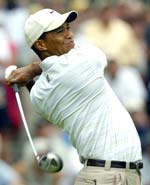 The recent war of words between world number one Tiger Woods and his former swing coach Butch Harmon has thrown a spotlight on the special relationship that can exist between leading players and their coaches.
The recent war of words between world number one Tiger Woods and his former swing coach Butch Harmon has thrown a spotlight on the special relationship that can exist between leading players and their coaches.
Many of today's best golfers are hardly ever seen on the practice range without their backup entourage and appear to consult their coaches the minute anything goes wrong.
The 25-year-old American Charles Howell III has been working with swing guru David Leadbetter since the age of 10 and admits he relies heavily on the Briton's advice.
"Without David, I wouldn't be here today playing top-level golf," Howell said earlier this year. "I don't think it's possible to become too reliant on one person.
"The coach or teacher is probably the most important relationship you can have out here."
Leadbetter, who also works with players like Ernie Els, Justin Rose, Bernhard Langer and Michelle Wie, is best known for his role in helping fellow Briton Nick Faldo and Zimbabwe's Nick Price become world number ones.
However, the Englishman, who cut his teeth as a coach in Zimbabwe during the late 1970s, knows full well that the relationship between player and teacher can sometimes turn sour.
"Occasionally, the chemistry or the magic just runs out," he told reporters earlier this month when asked to comment on the split in mid-2002 between Woods and Harmon.
"That's what happened with Nick (Faldo) and myself. The player changes a little bit, and so do you. Obviously Tiger got a great deal out of Butch, but the time came for both of them to move on."
EXTRAORDINARY RUN
Woods worked with Harmon during his extraordinary run of seven major triumphs in 11 starts from the 1999 U.S. PGA Championship to the 2002 U.S. Open, but has failed to win another since the pair went their separate ways.
Following this month's U.S. Open at Shinnecock Hills, Woods has competed in eight consecutive majors without victory and has been struggling with accuracy off the tee and from the fairway for much of the last 18 months.
Many of his peers believe it is well-nigh time for the 28-year-old American to reunite with Harmon, but such a development seems most unlikely given the verbal feud between the two earlier this month.
During the U.S. Open, Harmon told Sky Television that Woods was in denial over his form and had to accept he was not playing well.
In reply, a disgruntled Woods expressed puzzlement that Harmon would make such comments when he was no longer 'in the loop'.
"He doesn't really know what I'm working on, and he's never asked me," Woods told reporters. "I've never talked to him about it and no one knows.
"I don't understand why he would say anything like that, especially when we've been as close as we are."
In his monthly newsletter last week, Woods said he would be talking to Harmon.
"I plan to speak to Butch face-to-face and not communicate through the press," he said.
ANOTHER DIRECTION
"All I can say is that I'm disappointed Butch decided to speak publicly about our split. I simply decided to go in another direction and thought he understood."
Woods has always been a keen and perceptive student of the golf swing and, for the moment, is content to resolve things on his own.
In many ways, he is following the example set by the game's leading players of the 1950s, 1960s and 1970s.
Nine times major winner Ben Hogan, widely regarded as the best ball striker in golfing history, never had a teacher. Neither did six-times major champion Lee Trevino, nor Tom Watson, winner of five British Opens.
Even Jack Nicklaus, generally considered the best golfer of all time, did not consult regularly with his life-long teacher Jack Grout.
"I could never put down the value that Jack Grout had to me, but I really didn't run to him every five minutes for a golf lesson," Nicklaus said.
"Today, the players have got their coaches out there watching them warm up. I simply wanted to play golf, I didn't want to have a lesson just before I teed off."
What works for some clearly does not work for others. The special relationship between player and coach is a matter for the individual. Just ask Tiger Woods.










More from rediff